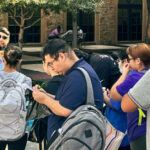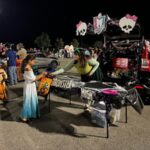Despite returning on-campus this semester, the idea of returning to normal should be rejected, President Cynthia Teniente-Matson said at the semi-virtual fall convocation Aug. 17.
“But as much as we have all hoped for a fall semester in which face coverings and social distancing were things of the past, the sobering reality is that the pandemic is not over,” Matson said.
Faculty and staff watched live in Texas A&M University-San Antonio’s auditorium, social distancing where possible. Those who couldn’t make it in person were able to watch the event through Zoom. About 90% of the crowd wore face masks.
The event featured pre-recorded videos, live reports from Faculty Senate and Staff Council and a live speech from Matson.
“These are the moments that connect us,” Matson said about campus traditions like convocation.
Kathryn Funk-Baxter, vice president for business affairs, asked for a moment of silence for those lost during the pandemic as their names were projected on a screen.
“Two of those employees (whose names were listed) were in my own division,” Funk-Baxter said. “And so I felt this very deeply.”
A new memorial garden is being developed in the courtyard between the Central Academic Building and the Madla Building in memory of those lost.
The pandemic has changed the way we work and think about work, Matson said. Technology has been transformed, expectations of teaching and learning have been reset and a deeper understanding of communicating digitally and virtually has been established.
Attendees watched a pre-recorded video of staff and faculty describing what they missed the most about working on campus.
The university inserted a COVID-19 report card in materials faculty and staff received that reflected on their accomplishments during the pandemic.
“If we were assigning scores during COVID, we earned a solid A,” Matson said. The pandemic is not over and the pre-COVID world will not be restored, but the university has a “visionary approach to pull our momentum moving forward.”
Matson announced Transforming Tomorrow Together as the university’s new strategic plan for the next five years. The concepts in this plan will be similar to the previous plan, Build. Impact. Transform, Matson said.
“Simply put, we haven’t changed who we are, we haven’t changed our direction. We’re just five years further down the road than we were,” Matson said.
A pre-recorded video of the deans of each college revealed the progress the university is making.
A new bachelor’s degree in general studies will be launching this semester, in addition to six new programs launching next fall including a doctoral program.
The university is welcoming its biggest freshman class at 1,050 students enrolled as of the week of Aug. 9. A&M-San Antonio is also welcoming 42 new Dream U.S. scholars making the total on campus 117 and 29 former foster youth bringing the total to 72.
According to a recent study of the economic impact of the university, the average graduate with a bachelor’s degree sees an average earning of $30,000 annually and $1.2 million in their working lifetime.
The university had an economic impact of $166.3 million on Bexar County in one year between its spending and students and alumni. This is equivalent to funding 2,156 county jobs, Matson said.
The university has developed a physical space for equity and inclusive excellence and will house the President’s Commission on Equity and Inclusive Excellence. The university is asking campus leaders to represent common values and demonstrate equity in their everyday tasks.
AT&T also presented the university with a $25,000 check to fund La Familia, a project that will focus on educational equity, enhance student learning and success and support the university in its initiatives.
This will provide students and families in the A&M-San Antonio community with reliable internet and will teach people how to connect digitally.
English Associate Professor Laurie Ann Guerrero performed a reading of her poem “Ars Politica: How To Make Art,” which she said she wrote in a time when she needed to be reminded of her inner strength and where it came from.
The poem reflected on ancestors and the effect they have on a person.
“You do not speak for the dead,” Guerrero said. “The dead speak for you.”







